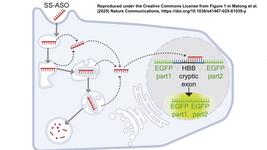CMN Weekly (4 November 2022) - Your Weekly CRISPR Medicine News
By: Gorm Palmgren - Nov. 4, 2022
Top picks
- In vivo CRISPR base editing of the PCSK9 gene in the liver of monkeys has led to a sustained 69% lowering of blood LDL-cholesterol for at least 476 days. The treatment was well tolerated, and the PCSK9 edit was transmitted in 0 of 436 animals. VERVE-101 is a single-course treatment for heterozygous familial hypercholesterolemia (HeFH). HeFH is associated with an increased risk of early onset of coronary artery disease. VERVE-101 is designed to completely inactivate PSCK9 by using adenine base editing to make a single, precise, A-to-G substitution.
- Feng Shang and co-workers have characterised the TPR-CHAT protease Csx29, associated with the CRISPR effector Cas7-11. They demonstrate that this CRISPR-associated protease (CASP) exhibits programmable RNA-activated endopeptidase activity against a sigma factor inhibitor to regulate a transcriptional response. The work reveals an RNA-guided function in nature which can be leveraged for RNA sensing applications in vitro and in human cells.
Research
- Cas12a variant-mediated cytosine and adenine base editors have been designed for multiplexed base editing. The system achieves elevated efficiencies and expanded targeting scope by combining highly active deaminases with Lachnospiraceae bacterium Cas12a (LbCas12a) variants. The authors suggest that the Cas12a variant-mediated base editors will serve as versatile tools for multiplexed point mutation.
- Chinese researchers propose a novel CRISPR-Cas12a unrestricted activation mode to improve its performance significantly. The new mode totally eliminates the need for an adjacent protospacer motif and accurately activates Cas12a through toehold-mediated strand displacement and branch migration, which is highly universal and ultra-specific.
- In a not yet peer-reviewed paper, American scientists have developed a method called DISCOVER-Seq+ for improved sensitivity of in vivo CRISPR off-target detection. DISCOVER-Seq+ discovered up to 5-fold more CRISPR off-target sites in immortalised cell lines, primary human cells, and mice than in previous methods.
- Scientists in Russia have improved the stability and specificity of the CRISPR-Cas9 system by selective modification of guide RNAs with 2′-fluoro and locked nucleic acid (LNA) nucleotides. The replacement of ribonucleotides with 2’-fluoro modified or LNA nucleotides increased the lifetime of the crRNAs, while other types of modification did not change their nuclease resistance.
Industry
- "What managers need to know about the emerging genetic revolution" is the title of an article in Business Horizons where the authors adopt an evolutionary perspective to understand the impact of the genetic revolution on firms regardless of industry. They present a tiered model of how the realms of matter, biology and human cognition and culture relate and how humans have shaped and then programmed each through technology. Building on this model, we provide a protocol for managers to consider the potential impacts of genetic programming on their organisations.
- Sherlock Biosciences and Shanghai-based Tolo Biotech will expand their collaboration to advance the development and adoption of CRISPR-based diagnostics. The agreement grants co-exclusive rights to Cas12 and Cas13 CRISPR diagnostic methods in markets outside the U.S. and Greater China.
- Epic Bio presented the first data supporting persistent and tunable gene activation using CRISPR-based epigenome editing. The data included a new activator in the GEMS (Gene Expression Modulation System) Platform and was presented at the 6th International Conference on Epigenetics and Bioengineering, on 29 October 2022, in Houston, Texas.
Detection
- Sensitive colourimetric detection of dual miRNAs is now possible with an AND logic-gate-based CRISPR-Cas12a biosensing platform. Overexpression of miR-205 and miR-944 in human serum can be detected, thereby allowing for differentiation between lung cancer patients and healthy people.
- In a not peer-reviewed paper, Chinese researchers present a method, DISCOVER-Seq+, forimproved sensitivity of in vivo CRISPR off-target detection. DISCOVER-Seq+ discovered up to 5-fold more CRISPR off-target sites in immortalised cell lines, primary human cells, and mice than in previous methods.
- Chinese researchers have developed a CRISPR-based nucleic acid test strip to diagnose prostate cancer accurately. The platform simultaneously identified PCA3 and KLK3 genes and allowed a detection limit of 500 fg/μL and 50 fg/μL, respectively.
Reviews
- Chinese researchers summarise the limitation of current CRISPR-based diagnostics. Then, they elaborate in detail on how five different types of microfluidics improve the performance of current CRISPR-based assays. In addition, they overlook the future development of CRISPR-based microfluidic assays and their applications.
Financial reports have been reported by
- Fate Therapeutics
- Intellia Therapeutics
- Allogene Therapeutics
- Precision Biosciences
- CRISPR Therapeutics
- Sangamo Therapeutics
- Editas Medicine
Upcoming presentations for ASH 2022 (American Society of Hematology)
- Beam Therapeutics: New preclinical data highlighting non-genotoxic conditioning regimens for patients with sickle cell disease ahead of autologous transplant.
- Graphite Bio: Development of a Beta-Globin Gene Replacement Strategy As a Beta-Thalassemia Therapy & Single-Cell RNA Sequencing of Sickle Cell Reticulocytes to Identify Beta-Globin Genotypes and Associated Gene Expression Differences.
- Caribou Biosciences: A First-in-Human Phase 1, Multicenter, Open-Label Study of CB-010, a Next-Generation CRISPR-Edited Allogeneic Anti-CD19 CAR-T Cell Therapy with a PD-1 Knockout, in Patients with Relapsed/Refractory B Cell Non-Hodgkin Lymphoma (ANTLER Study).
- Allogene Therapeutics: Universal Updated Phase 1 Data Highlights Role of Allogeneic Anti-BCMA ALLO-715 Therapy for Relapsed/Refractory Multiple Myeloma.
- CRISPR Therapeutics: CTX110 Allogeneic CRISPR-Cas9–Engineered CAR-T Cells in Patients (Pts) with Relapsed or Refractory (R/R) Large B-Cell Lymphoma (LBCL): Results From the Phase 1 Dose Escalation CARBON Study.
- Precision BioSciences: Effective Cell Dose and Functional Attributes of Azercabtagene Zapreleucel (azer-cel; PBCAR0191) Associate with Allogeneic CAR T-Cell Safety and Efficacy in Patients with Relapsed/Refractory B-Cell Lymphoma.
- Cellectis: AMELI-01: A Phase I Trial of UCART123v1.2, an Anti-CD123 Allogeneic CAR-T Cell Product, in Adult Patients with Relapsed or Refractory (R/R) CD123+ Acute Myeloid Leukemia (AML).
To get more of the CRISPR Medicine News delivered to your inbox, sign up to the free weekly CMN Newsletter here.
Tags
CLINICAL TRIALS
IND Enabling
Phase I
Phase II
Phase III
Recurrent or Progressive High-grade Glioma, (NCT06737146)
Sponsors:
Suzhou Maximum Bio-tech Co., Ltd.
Sponsors:
Suzhou Maximum Bio-tech Co., Ltd.
IND Enabling
Phase I
Phase II
Phase III
Advanced Peritoneal Malignancies or Abdominal Metastatic Solid Tumors, (NCT06912152)
Sponsors:
Zhejiang University
Sponsors:
Zhejiang University
IND Enabling
Phase I
Phase II
Phase III







